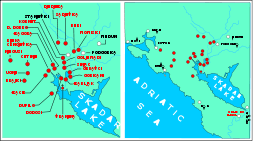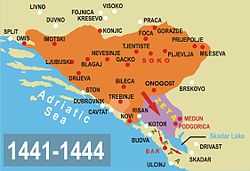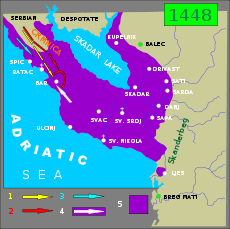Stefan Crnojević
| Stefan Crnojević | |
|---|---|
| Lord of Zeta | |
| Coat of arms |
 |
| 1451–1465 | |
| Predecessor | Đurađ Đurašević Crnojević |
| Successor | Ivan Crnojević |
| Spouse(s) | Maria Kastrioti, also called Mamica |
| Noble family | Crnojević |
| Father | Đurađ Đurašević Crnojević |
| Mother | A daughter of Koja Zaharia |
| Died | 1465 |
| Buried | Kom Monastery |
| Religion | Eastern Orthodox Christianity (Serbian Church) |
Stefan Crnojević (Serbian Cyrillic: Стефан Црнојевић), known as Stefanica (Стефаница; fl. 1426–died 1465) was the Lord of Zeta between 1451 and 1465. Until 1441, he was one of many governors in Zeta, which at that time was a province of the Serbian Despotate. He then aligned with Stefan Vukčić Kosača and remained his vassal until 1444 when he accepted Venetian suzerainty. In Venetian–held Lezhë, on 2 March 1444, Stefan and his sons forged an alliance with several noblemen from Albania, led by Skanderbeg, known as the League of Lezhë. In 1448 he returned under suzerainty of Serbian Despot Đurađ Branković. In 1451, Stefan took over the leadership of the Crnojevići and became the ruler of a large part of Zeta.
Early life and family
Stefan was born as the third son of Đurađ Đurašević Crnojević, and the daughter of Albanian nobleman Koja Zaharia of the Zaharia family. Stefan had three brothers: Đurašin Đurašević, Gojčin Crnojević and a brother with an unknown name and historical role.[1] The earliest documents which mentions him is from 1426.[2] Stefan was nicknamed "Stefanica".[3]
Stefan had three sons, Ivan, Andrija, nicknamed as the brave Albanian and Božidar, who in other sources is mentioned as his brother. At that time Zeta was considered as integral part of Albania while its noblemen were sometimes referred to as Albanians.[4]
Reign
Vassalage

At adulthood, Stefan became one of the many noblemen who governed parts of Zeta within the Serbian Despotate, but did not agree with the other Crnojević members and pursued his goals on his own, outside the mainstream of the family. With the temporary Ottoman capture of the Serbian Despotate's main continental territories in 1441, Despot Đurađ Branković came from Ragusa to Zeta to organize resistance and restore his control over the occupied parts. His attempt failed and resulted with the blinding of the despot's two captured sons in retaliation. With his departure back to Hungary, Stefan aligned with Stefan Vukčić Kosača of Hum.[5] At the end of September 1441 Kosača captured the territory of upper Zeta on the left bank of Morača. Stefan Crnojević, who represented the whole Crnojević family, joined him in this campaign and was awarded by Kosača with control over five villages. He kept two of them (Goričane and Kruse) under his control and gave the other three to his brothers.[6]

Stefan married Maria Kastrioti, also called Mamica, the oldest daughter of the Lord of Mat Gjon Kastrioti.[7] This family link became really important when in November 1443 Gjon's son and Maria's brother, George Kastrioti Skanderbeg rebelled in Albania against his Ottoman sovereign. According to Vasilije Petrović-Njegoš Stefan sent soldiers under the command of Božidar to help Skanderbeg in his fight against Ottomans, but Lekë Dukagjini and members of Zaharia family ambushed and killed them.[8]

1. Altoman offensive; 2. Stefan Crnojević offensive; 3. Paštrovići offensive; 4. Venetian-supporting Mrkojevići; 5. Venetian properties.
In 1444 Stefan Crnojević found strong new protectors in the Venetian Republic. In Venetian-held Lezhë on 2 March 1444 Stefan and his sons forged an alliance (League of Lezhë) with several noblemen from Albania, including Skanderbeg.[9] With the restoration of the Serbian Despotate after the Crusade, Stefan gave his loyalty to Despot Đurađ Branković in 1448. Together with Branković and Skanderbeg he attacked Venetian held Bar and Ulcinj.[10] Venetians were reluctant to fight against Serbian Despotate and had intention to estrange Branković and Skanderbeg. In July 1448 Jakov Dolfin, the governor of Bar, was victorious in the battle against Altoman's forces whose part was commanded by Stefan.[11]
Lord of Zeta
After the disappearance of Stefan's brother Gojčin Crnojević from political life in 1451, Stefan took over the leadership of the house of Crnojević and became the ruler of a large part of Zeta. Stefan was never good with his brothers and always led politics on his own. To strengthen his position, he decided to immediately seek foreign protection. In 1452 he allied himself with Venice and recognized its authority over the region and was subsequently entitled Duke of Upper Zeta.[12] The reasons of the alliance are related to his anticipation of the downfall of the Serbian Despots. Venetan dodge Francesco Foscari wrote a letter to Stefan in 1455 asking him to return to Budva its territory he captured.[13] In 1455 the Ottomans invaded Serbia and conquered all of its territories south of the Western Morava river, completely cutting Zeta off from the core of the Despotate. Therefore, Duke Stefan Crnojević along with representatives from all 51 municipalities from Upper Zeta signed an agreement the same year with the Venetians in Vranjina, by which Upper Zeta accepted Venetian rule. Venice came to rule only the cities, while all internal affairs were left to duke Stefan. The Republic of Venice also bound itself not to mettle with the ecclesiastical authority Serbian Orthodox Metropolitan of Zeta in any way. Montenegro slowly became the name of Stefan's Zetan realm. He reigned peacefully without the intervention of Venice and the Ottomans until his death in late 1464 or the beginning of 1465, when his son Ivan succeeded him.
Ancestry
| Ancestors of Stefan Crnojević | |||||||||||||||||||||||||||||||||||||||||||||||||||||||||||||||||||||||||||||||||||||||||||||||||||||||||||||||||||||||||||||||||||||||||||||||||||||||||||||||||||||||||||||||||||||||||||||||||||||||||||||||||||||||||||||||||||||||||||||||||||||||
|---|---|---|---|---|---|---|---|---|---|---|---|---|---|---|---|---|---|---|---|---|---|---|---|---|---|---|---|---|---|---|---|---|---|---|---|---|---|---|---|---|---|---|---|---|---|---|---|---|---|---|---|---|---|---|---|---|---|---|---|---|---|---|---|---|---|---|---|---|---|---|---|---|---|---|---|---|---|---|---|---|---|---|---|---|---|---|---|---|---|---|---|---|---|---|---|---|---|---|---|---|---|---|---|---|---|---|---|---|---|---|---|---|---|---|---|---|---|---|---|---|---|---|---|---|---|---|---|---|---|---|---|---|---|---|---|---|---|---|---|---|---|---|---|---|---|---|---|---|---|---|---|---|---|---|---|---|---|---|---|---|---|---|---|---|---|---|---|---|---|---|---|---|---|---|---|---|---|---|---|---|---|---|---|---|---|---|---|---|---|---|---|---|---|---|---|---|---|---|---|---|---|---|---|---|---|---|---|---|---|---|---|---|---|---|---|---|---|---|---|---|---|---|---|---|---|---|---|---|---|---|---|---|---|---|---|---|---|---|---|---|---|---|---|---|---|---|---|
| |||||||||||||||||||||||||||||||||||||||||||||||||||||||||||||||||||||||||||||||||||||||||||||||||||||||||||||||||||||||||||||||||||||||||||||||||||||||||||||||||||||||||||||||||||||||||||||||||||||||||||||||||||||||||||||||||||||||||||||||||||||||
References
- ↑ M. Bešić, Zarij (1970), Istorija Crne Gore / 2. Crna gora u doba oblasnih gospodara. (in Serbian), Titograd: Redakcija za istoiju Crne Gore, p. 190, OCLC 175122851,
Ђурађ је имао четири сина
- ↑ Istorijski Glasnik. 1969. p. 30. Retrieved 24 April 2013.
За Стефана Црнојевића (помиње се од 1426. годи- не),
- ↑ Institut zur Erforschung des Deutschen Volkstums im Süden und Südosten in München; Mathias Bernath; Felix von Schroeder; Südost-Institut München, Universität Passau. Institut für Ostbairische Heimatforschung, Südostgemeinschaft Wiener Hochschulen, Deutsches Auslandswissenschaftliches Institut (Berlin, Germany) (1974). Südosteuropäische Arbeiten. Oldenbourg. p. 336. ISBN 978-3-486-47961-4. Retrieved 22 April 2013.
Stefan Crnojevic (Stefanica), Herrscher der Zeta 1426—1465, Sohn des Djuradj C. Er sicherte sich die Macht dadurch, daß er seine Brüder ausschaltete und
- ↑ Bešić 1970, p. 137
Чињеница да историјски извори који говоре о Зети у XIV и XV вијеку често употребљавају и шири појам „Албанија" изискује извјесно објашњење...Иначе су Дубровчани земље Балшића и Црнојевића редовно називали Зетом...они су ... подвлачили да Зета припада Србији....називали су Балшиће „српском господом"...Константин Филозоф, називао је Балшу „арбаваским господином"...Которани.... поручивали су им да ће,ако их они не прихвате, морати да се потчине „или Арбавасима, или Србима или Турцима"...Како им је у том тренутку пријетила опасност од Радича Црнојевића, СандаљаХранића и турских провала, јасно је кога су уврстили у Арбанасе... Стефан Душан назива ... је он Поморје изједначио са Албанијом)
- ↑ Medieval and Renaissance Studies (1978). Viator. University of California Press. pp. 388–389. ISBN 0-520-03608-5.
- ↑ Bešić 1970, p. 196
У другој половини септембра 1441. год. Стефан Вукчић је провалио у Горњу Зету и најприје заузео крајеве до Мораче. Придобио је Стефаницу Црнојевића, који је још био у слози с браћом и иступао у име читаве породице. Зато му је на oсвојеномподручју уступио пет катуна... Стефашца је по један катун уступио сваком брату, а сам задржао Горичане и Крусе
- ↑ Andrija Veselinović; Radoš Ljušić (2008). Srpske dinastije. Službene glasink. p. 127. ISBN 978-86-7549-921-3. Retrieved 21 April 2013.
- ↑ Petrović-Njegoš, Petar I (1835), Кратка Историја Црне Горе (Short History of Montenegro) (in Serbian), retrieved 17 January 2012,
У овога Стефана бише три сина: Иван, Божидар и Андрија, наречени Арванит Храбри.... Стефан бјеше у вријеме великога и славнога у великијем дјелам Георгија Кастриота, реченога Скендер-бега коме пошиљаше помоћ противу Тураках под начелством сина својега Божидара, којега вјероломни Лека Дукађин, уједно са Захаријем Амнисфером, књазом од неке части Арбаније и сојузником Скендер-беговијем, дочека бусијом на некојему мјесту и обојицу уби, и велику жалост Кастриоту и свој његовој војсци, како и Стефану, учини.
- ↑ Schmitt 2001, p. 297
Nikola und Paul Dukagjin, Leka Zaharia von Dagno, Peter Span, Herr der Berge hinter Drivasto, Georg Strez Balsha sowie Johann und Gojko Balsha, die sich zwischen Kruja und Alessio festgesetzt hatten, die Dushman von Klein-Polatum sowie Stefan (Stefanica) Crnojevic, der Herr der Oberzeta
- ↑ Schmitt 2001, p. 302
Georg Branković, Stefan Crnojević und Skanderbeg erschienen mit starken heeren vor den venezianischen Stadten [Georg Branković, Stefan Crnojević and Skanderbeg appeared with a strong army before the Venetian cities]
- ↑ Dragoslav Srejović; Slavko Gavrilović; Sima M. Ćirković (1982). Istorija srpskog naroda: knj. Od najstarijih vremena do Maričke bitke (1371). Srpska književna zadruga. p. 266. Retrieved 22 April 2013.
У међувремену, неочекивано, средином јула 1448, барски потестат Јаков Долфин, издашно се служећи лукавством, потукао је Алтоманову војску, чијим је једним делом командовао Стефаница Црнојевић.
- ↑ Ćirković, Sima M. (2004-06-14). The Serbs. John Wiley & Sons. p. 107. ISBN 978-0-631-20471-8. Retrieved 20 January 2012.
- ↑ Ivan Pederin (1990). Mletačka uprava, privreda i politika u Dalmaciji: 1409-1797. Časopis "Dubrovnik". p. 8. Retrieved 25 April 2013.
Sources
- Bešić, Zarij M. (1970), Istorija Crne Gore / 2. Crna gora u doba oblasnih gospodara. (in Serbian), Titograd: Redakcija za istoiju Crne Gore, OCLC 175122851
- Schmitt, Oliver Jens (2001), Das venezianische Albanien (1392-1479), München: R. Oldenbourg Verlag GmbH München, ISBN 3-486-56569--9
| Stefan Crnojević Crnojević family Born: 1426 Died: 1465 | ||
| Preceded by Gojčin Crnojević |
Lord of Upper Zeta 1451–1465 |
Succeeded by Ivan Crnojević |
| ||||||||||||||
| ||||||||||||||||||||||||||